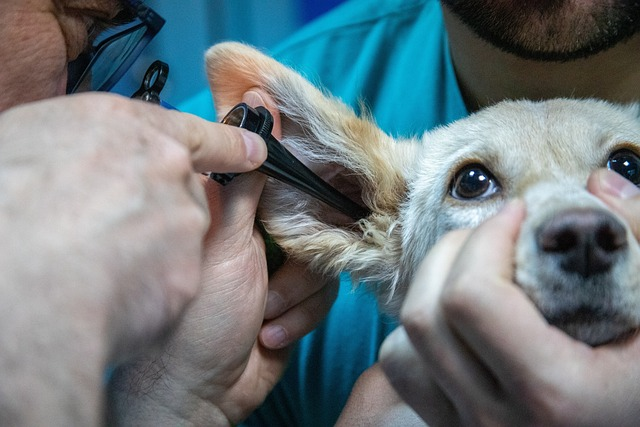Dog Ear Mites: Causes, Symptoms, and Effective Treatments

Your dog’s ears serve as an entrance to their world, picking up on the sounds of joyful barking, the whisper of leaves, and the comforting cadence of daily existence.
However, lurking within this intricate auditory system, there exists a tiny yet formidable foe known as ear mites.
These microscopic pests, scientifically referred to as Otodectes cynotis, are the culprits behind a common canine ailment.
In this comprehensive guide, we’ll delve deep into the world of ear mites in dogs, shedding light on their nature, the havoc they wreak within the ear canal, and the potential to cause ear infections.
Moreover, we’ll equip you with practical knowledge on how to both treat and prevent ear mite infestations, ensuring your furry friend enjoys a life free from the discomfort and irritation that these tiny intruders can cause.
So, let’s embark on this journey to understand, combat, and ultimately conquer dog ear mites in your beloved canine companion.
Causes of Ear Mites in Dogs
Ear mites in dogs are primarily caused by a tiny parasitic mite known as Otodectes cynotis. These mites are highly contagious and can easily spread from one animal to another.
The common causes of ear mites in dogs include:
- Direct Contact with Infested Animals: The most common mode of transmission occurs through direct contact with an infected animal. This can happen during activities like playing, grooming, or even just socializing with other dogs.
- Environmental Exposure: Ear mites can survive in the environment for a short period of time. They may be present in areas where infested animals have been, such as kennels, shelters, or pet grooming facilities. Contact with contaminated bedding, toys, or living spaces can lead to infestation.
- Mother-to-Puppy Transmission: Puppies can contract ear mites from their mother, especially if she is infested. The mites can be passed from the mother to her offspring during nursing or close contact.
- Weakened Immune System: Dogs with weakened immune systems, due to factors like illness, malnutrition, or stress, are more susceptible to ear mite infestations. A compromised immune system can make it harder for the dog’s body to naturally fight off the mites.
- Multi-Pet Households: In households with multiple pets, especially if one is infested, there’s a higher risk of ear mites spreading among the animals. Close living quarters increase the likelihood of mites moving from one pet to another.
- Outdoor Activities:Dogs that spend a lot of time outdoors, particularly in areas with tall grass or wooded environments, may have a higher risk of coming into contact with ear mites.
- Delayed or Inadequate Treatment: If a previous ear mite infestation was not completely treated or if treatment was not administered as directed by a veterinarian, there’s a risk of a recurrence or the mites becoming more resistant.
It’s crucial to recognize that although ear mites are frequently linked with dogs, they can also impact other animals such as cats, rabbits, and ferrets.
Therefore, if you have multiple pets, it’s crucial to treat all of them if one is diagnosed with ear mites to prevent cross-infestation.
Ear Mites in Dogs: Signs & Symptoms
Ear mites, scientifically referred to as Otodectes cynotis, are minuscule parasites that can inhabit a dog’s ear canal. These tiny pests can lead to discomfort and even more severe ear issues if left untreated.
Understanding the signs and recognizing the symptoms of ear mites is crucial for maintaining your furry friend’s ear health.
Here explore the origins of ear mites, how they affect dogs, and the telltale signs to look out for.

Symptoms of Ear Mites in Dogs:
Identifying the signs of an ear mite infestation is crucial for timely intervention.
Keep an eye out for the following symptoms:
- Ear Scratching: Persistent scratching of the ears is one of the most common signs. If your dog is frequently pawing at or rubbing their ears, it may be an indication of discomfort.
- Head-Shaking: Dogs with ear mites often exhibit vigorous head shaking in an attempt to alleviate the irritation.
- Ear Odor: A foul smell emanating from the ears may indicate the presence of ear mites, along with the buildup of wax and debris.
- Redness and Inflammation: The ear canal may appear red and inflamed, sometimes accompanied by swelling.
- Dark Discharge: Ear mites can cause a black, crumbly discharge resembling coffee grounds, which is a mixture of wax, debris, and mites.
- Hair Loss and Sores: In severe cases, dogs may develop hair loss around the ears and even sores due to excessive scratching.
- Behavioral Changes: If your dog becomes more irritable, anxious, or exhibits signs of distress, it could be a result of the discomfort caused by ear mites.

Dog Ear Mite Treatment
Dealing with an ear mite infestation in your beloved canine companion can be a distressing experience.
These minuscule parasites, while small in size, can cause significant discomfort and irritation for your furry friend.
Explore effective strategies for treating ear mites in dogs, providing relief and restoring your pet’s well-being.
1. Thorough Ear Cleaning
The first step in treating ear mites is to clean your dog’s ears thoroughly.
Gently wipe away any discharge, wax, or debris using a veterinarian-recommended ear-cleaning solution.
Be sure to follow the product instructions and use a soft, clean cloth or cotton ball to avoid further irritation.
2. Topical Treatments
There are various over-the-counter and prescription topical treatments available for ear mites.
These solutions often contain parasiticides that target the mites, helping to eliminate them.
It’s essential to consult your veterinarian to determine the most suitable treatment for your dog’s specific condition.
3. Prescribed Medications
In severe cases or when secondary infections have occurred, your veterinarian may prescribe oral medications, such as antibiotics or anti-inflammatory drugs.
These medications can help alleviate inflammation and discomfort, allowing the ears to heal.
4. In-Home Remedies
Some natural remedies, such as diluted hydrogen peroxide or mineral oil, can be used under the guidance of a veterinarian to help suffocate and remove ear mites.
However, it’s crucial to exercise caution and consult a professional before attempting any at-home treatments.
5. Regular Vet Check-ups
Continuous monitoring of your dog’s ears is essential throughout the treatment process.
Schedule regular check-ups with your veterinarian to assess the progress and make any necessary adjustments to the treatment plan.
6. Environmental Cleaning
To prevent re-infestation, it’s crucial to thoroughly clean and disinfect your dog’s living environment.
Wash bedding, toys, and grooming tools regularly, and vacuum carpets and upholstery to remove any potential mite habitats.
7. Isolation and Treatment of Infected Pets
If you have multiple pets, it’s vital to isolate and treat any infected animals to prevent the spread of ear mites.
Consult your veterinarian for specific guidance on how to manage a multi-pet household during an infestation.

FAQs
1. How to Diagnose Ear Mites in Dogs?
Diagnosing ear mites in dogs involves a thorough examination of the ear canal. Here are the steps to follow:
- Visual Inspection
- Microscopic Examination
- Symptom Assessment
Remember, it’s crucial to consult a veterinarian for an accurate diagnosis and appropriate treatment plan.
2. How long does it take to get rid of ear mites in dogs?
The duration of treatment for ear mites in dogs can vary depending on the severity of the infestation and the chosen treatment method.
Generally, it can take anywhere from a few weeks to a couple of months to completely eradicate ear mites.
It’s crucial to follow your veterinarian’s recommended treatment plan and attend follow-up appointments to monitor progress.
Additionally, thorough environmental cleaning and preventive measures can help prevent re-infestation.
3. What are 3 Home Remedies For Ear Mites In Dogs?
While consulting a veterinarian is always recommended for proper diagnosis and treatment, there are some home remedies that can help alleviate ear mite discomfort:
- Mineral Oil or Olive Oil
- Diluted Apple Cider Vinegar
- Diatomaceous Earth
Always consult your veterinarian before attempting any home remedies, as some methods may not be suitable for all dogs or could potentially exacerbate the issue if not used correctly.

Final Notes
In the intricate world of our furry companions, even the tiniest intruders like ear mites can cause significant discomfort.
Recognizing the signs, understanding the causes, and seeking prompt treatment are essential steps in ensuring your dog’s ear health. Remember, consulting a veterinarian for a proper diagnosis and treatment plan is crucial.
By following the recommended treatments and preventive measures, you can provide your beloved canine with the comfort and relief they deserve.
Regular check-ups, a clean living environment, and prompt attention to any signs of ear trouble will go a long way in keeping your furry friend’s ears healthy and free from the bothersome presence of ear mites.
Here’s to happy, healthy ears and a thriving, contented canine companion!
